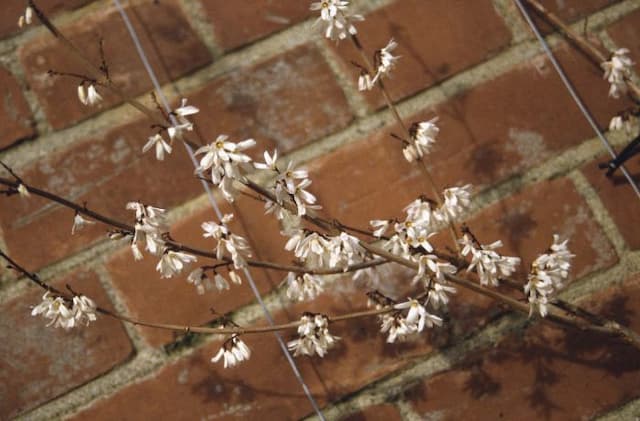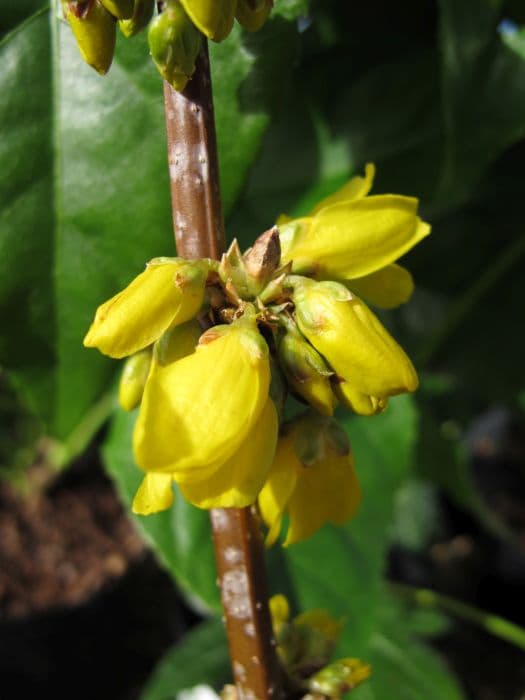Japanese Privet Ligustrum japonicum
ABOUT
The Japanese privet is an evergreen shrub with a dense, multi-stemmed form that makes it a popular choice for privacy hedges and ornamental plantings. Its glossy, green leaves are oval-shaped and come to a point at the tip, contributing to its lush appearance throughout the year. The foliage may have a slightly wavy edge, adding texture to its dense canopy. During late spring to early summer, the Japanese privet produces clusters of small, fragrant white flowers that are quite attractive and can draw in butterflies and other pollinators. These blooms give way to small, round berries that mature to a dark, purplish-black color. The berries are favored by birds and can add a show of color in the landscape during the late summer and autumn months. The bark of the Japanese privet is smooth and gray, providing a subtle contrast to its shiny leaves. Overall, the appearance of this plant is orderly and can be easily shaped through pruning, which allows for its common use in formal garden settings. Its ability to maintain a neat appearance throughout the year, along with its showy flowers and attractive berries, makes the Japanese privet a versatile and popular plant in many gardens.
About this plant
 Names
NamesSynonyms
Japanese Privet, Wax-Leaf Privet, Wax Ligustrum, Japanese Ligustrum.
Common names
Ligustrum lucidum auct. non Thunb., Ligustrum japonicum f. aureo-variegatum (Rehder) Rehder, Ligustrum philippinense Perkins, Ligustrum quihoui Carrière.
 Toxicity
ToxicityTo humans
Japanese privet is considered to be poisonous to humans. If ingested, parts of the plant, particularly the berries, can cause symptoms such as nausea, vomiting, diarrhea, and abdominal pain. In severe cases, ingestion may lead to dizziness, headache, and in rare instances, convulsions or changes in heart rate. It is recommended to seek medical attention if ingestion is suspected.
To pets
Japanese privet is also toxic to pets, including dogs and cats. Ingesting the leaves or berries can lead to gastrointestinal upset, which can present as vomiting, diarrhea, and loss of appetite. More severe symptoms can include coordination problems, increased heart rate, and weakness. If a pet has consumed any part of the plant, it is important to contact a veterinarian immediately.
 Characteristics
CharacteristicsLife cycle
Perennials
Foliage type
Evergreen
Color of leaves
Green
Flower color
White
Height
10-15 feet (3-4.5 meters)
Spread
5-6 feet (1.5-1.8 meters)
Plant type
Shrub
Hardiness zones
7-10
Native area
Japan
Benefits
 General Benefits
General Benefits- Privacy Screening: Japanese Privet can be used to create a dense hedge or screen, providing privacy for homes and gardens.
- Ornamental Qualities: With its glossy evergreen leaves and creamy-white flowers, it adds aesthetic appeal to landscapes.
- Drought Tolerance: Once established, Japanese Privet is quite tolerant of drought, making it suitable for xeriscaping or low-water gardens.
- Pest Resistance: This plant is generally resistant to pests, which reduces the need for chemical treatments.
- Shade Tolerance: It can grow in full sun to partial shade, offering versatility in landscape design.
- Soil Adaptability: Japanese Privet adapts to a wide range of soil types, even thriving in poor soils.
- Wildlife Attraction: The flowers can attract pollinators, while the berries provide food for birds.
- Windbreak: When planted in rows or groups, it can act as a windbreak, protecting gardens and property from strong winds.
- Erosion Control: Its root system helps stabilize soil, which can prevent erosion on slopes.
- Easy Propagation: Can be easily propagated from cuttings, making it economical to spread across large areas or share with others.
- Fast Growth: Rapid growth rate allows for quick establishment and achievement of desired height when used as a hedge.
 Medical Properties
Medical Properties- Anti-inflammatory: Ligustrum japonicum has been traditionally used to reduce inflammation.
- Antioxidant: The plant contains compounds that are believed to have antioxidant properties.
- Hepatoprotective: Some studies suggest that it may offer protection against liver damage.
- Antimicrobial: Extracts from Ligustrum japonicum have been shown to exhibit antimicrobial activity against certain pathogens.
- Immunomodulatory: There is evidence to suggest that it can modulate immune system responses.
 Air-purifying Qualities
Air-purifying QualitiesThis plant is not specifically known for air purifying qualities.
 Other Uses
Other Uses- Privacy Screens: Ligustrum japonicum, commonly known as Japanese privet, is often used to create dense, evergreen privacy screens or hedges in landscaping due to its fast growth and thick foliage.
- Topiary Art: The plant can be meticulously pruned and trained into various shapes and forms for decorative purposes in gardens, showcasing its potential for topiary art.
- Erosion Control: Japanese privet's extensive root system can help stabilize soil on slopes or areas prone to erosion, aiding in soil conservation efforts.
- Windbreaks: The dense growth habit of the Ligustrum japonicum makes it an effective windbreak, protecting smaller plants and reducing wind speed in gardens and landscapes.
- Noise Barrier: Planting a row of Japanese privet can help to reduce noise pollution by absorbing and deflecting sound waves with its thick branches and leaves.
- Bonsai: Due to its adaptability and attractive foliage, Japanese privet can be cultivated as a bonsai plant, allowing enthusiasts to enjoy this species in miniature form.
- Nectar Source: The white flowers of Ligustrum japonicum can provide a valuable source of nectar for bees and other pollinating insects during its blooming season.
- Cultural Symbolism: In some cultures, Ligustrum species are symbolic and may be planted for their aesthetic appeal or cultural significance in certain traditions or ceremonies.
- Bird Habitat: The dense foliage of the Japanese privet can provide shelter and nesting sites for birds, enhancing biodiversity in a garden setting.
- Photography Subject: Due to its elegant form, especially when in bloom or neatly pruned, Japanese privet is often used as a subject for gardening and landscape photography.
Interesting Facts
 Feng Shui
Feng ShuiWax-leaf privet, or Ligustrum japonicum, is not traditionally used in Feng Shui practice.
 Zodiac Sign Compitability
Zodiac Sign CompitabilityWax-leaf privet is not used in astrology practice.
 Plant Symbolism
Plant Symbolism- Resilience: Ligustrum japonicum, commonly known as Japanese privet, is a robust plant that can tolerate a variety of growing conditions, symbolizing the ability to withstand and adapt to different life challenges.
- Protection: With its dense foliage and use in hedges, the Japanese privet signifies protection and the safeguarding of one's space from external intrusions.
- Renewal: The plant’s capacity to grow back even after heavy pruning makes it a symbol of renewal and the possibility of new beginnings or a fresh start.
- Privacy: As it's often planted to create privacy screens, the Japanese privet represents the need for personal privacy and boundary setting in one's life.
- Purity: The white flowers of the Ligustrum japonicum can symbolize purity and cleanliness, which could be interpreted as living a life of simplicity and moral clarity.
 Water
WaterThe Japanese privet requires deep watering to ensure the soil surrounding its roots is moist. During the growing season, it should be watered once a week with about 1 to 1.5 gallons of water, depending on the soil dryness and weather conditions. In periods of drought or extreme heat, you may need to increase watering frequency. For mature plants, watering can be reduced to every two weeks, especially if natural rainfall keeps the soil adequately moist. Ensure that the soil has good drainage to prevent waterlogging and root rot.
 Light
LightThe Japanese privet performs best in full sun to partial shade. It is adaptable but thrives with at least four hours of direct sunlight per day. The ideal spot for planting a Japanese privet would be in an area where it can receive the morning sun and some afternoon shade, especially in regions with hot summers.
 Temperature
TemperatureJapanese privets are quite temperature resilient and can survive in temperatures as low as 0°F, though some damage may occur. They grow optimally when the temperature ranges between 40°F and 90°F. Ensure protection from extreme winter winds by planting in a sheltered location to prevent dieback, especially in the northern end of their growing range.
 Pruning
PruningPruning Japanese privet maintains its shape and promotes a more dense growth habit, which is especially important if being used as a hedge. The best time to prune is in late winter or early spring before new growth starts. It can be pruned again in mid-summer if necessary. Depending on your desired shape and the vigor of the plant, pruning may need to be done once or twice a year.
 Cleaning
CleaningAs needed
 Soil
SoilJapanese Privet thrives in well-draining soil with a pH between 6.0 and 7.5. A mix of loamy soil, peat, and sand or perlite in equal parts encourages good drainage and aeration. Compost can be added to enrich the soil, improving the overall health and vigor of the plant.
 Repotting
RepottingJapanese Privet should be repotted every 2 to 3 years to refresh the soil and accommodate root growth. Younger plants may benefit from more frequent repotting, while established, larger specimens can be repotted less often.
 Humidity & Misting
Humidity & MistingJapanese Privet prefers moderate to high humidity levels but is quite adaptable to less humid conditions. It is best to maintain humidity around 40-50% for optimal growth. Avoid placing it near heating vents which can dry out the air excessively.
 Suitable locations
Suitable locationsIndoor
Place Japanese Privet in bright, indirect light and water moderately.
Outdoor
Plant in full sun to part shade, water regularly, and protect from strong winds.
Hardiness zone
7-10 USDA
 Life cycle
Life cycleLigustrum japonicum, commonly known as Japanese privet, starts its life cycle from a seed, which upon germination, develops into a seedling. As it grows, it forms a woody stem and lush foliage, entering the vegetative stage where it focuses on growth and root expansion. During the reproductive stage, usually in late spring to early summer, it produces fragrant white flowers that attract pollinators. Following pollination, these flowers develop into small, oval fruits or berries that ripen to a dark, often black color. The fruits, when fully mature, are dispersed by birds and other wildlife, which eat the berries and excrete the seeds to new locations. Over time, without human intervention, Japanese privet can naturalize and spread, sometimes aggressively, entering a mature stage with robust growth and continuous cycles of flowering and fruiting annually until the end of its lifespan.
 Propogation
PropogationPropogation time
Spring-summer
The most popular method for propagating Ligustrum japonicum, commonly known as Japanese privet, is through semi-hardwood cuttings, which involves taking a section of the plant's stem that is not overly mature and has begun to harden. The ideal time for this method is during the late summer to early fall. Cuttings should be about 4 to 6 inches (10 to 15 centimeters) long with several leaves left at the top. The lower leaves are removed and the cut end is dipped in rooting hormone to enhance root development. The cutting is then placed in a well-draining soil mix and kept moist and warm until roots have established, after which it can be transplanted to a permanent location.









